My dad promised me an R-boat if we won the coast championship this
year, and we did the best possible.
— Tommy Lee
as reported by Fox Case in "The "Starboard Watch",
Los Angeles Evening Herald, July 1925
In the Spring of 1925, yachtsman Don Lee of Los Angeles made a challenge to his son Tommy. If he won the Pacific Coast Star Championship, the elder Lee would give his heir a new R-boat as a reward. Whether inspired by this offer or base competitive instinct, the young Lee sailed his Star SATELLITE to victory at the Pacific Coast Yachting Assoc. (PCYA) regatta in Victoria, B.C. to win that title. Thus began the story of the PIRATE.
At the Victoria regatta, the Lees witnessed the superiority of the Seattle Yacht Club boat SIR TOM, winner there of both the Sir Thomas Lipton Cup and the Isherwood Cup in the R class. So impressed was he by the skill of her skipper/designer, L. E. "Ted" Geary, Don Lee ordered a custom R-boat design from Geary and persuaded him to skipper Lee's huge schooner INVADER in the 1926 Honolulu Race.
By August, Geary had the design underway and, in the fall of 1925, the craftsmen at Seattle's Lake Union Dry Dock Co. began construction on PIRATE. Early in the process, it was decided to make her the best built R-boat on the coast. Two huge Douglas Fir timbers were shaped into a keel/horn timber centerline structure that would keep her fine shape fair and strong for a very long time. A double planked hull was specified and only the best matrials were used to build her; Burma teak outside and Western Red Cedar for the interior planking. This combination made a very rigid hull; light and extremely rot-resistant.
On the construction plans, Geary specified that there were to be no scarf joints in the stringers, clamps or shelves through the middle portion of the boat. In fact, the builders went one better and all of these long structural members are full-length pieces of Douglas fir with no joints of any kind.
For the deck, the Lees had requested teak planking. To keep this light and strong, a sub-deck of double diagonal red cedar was laid and the teak applied on top with sporty white caulking in the seams. The housetop was double diagonal planked red cedar, canvas covered and painted Sally green.
On April 4, 1926, PIRATE was christened and launched on Lake Union in Seattle. A sizeable crowd of boat builders, yachtsmen and the curious showed up to witness the event. Held on a sunny afternoon, the proceedings were recorded in photographs by the renowned firm of Webster - Stevens. The boat was a gleaming example of the best boat building of the time. The same year, Lake Union Drydock had begun building the first of the legendary "Lake Union Dreamboat" line of motor yachts.
PIRATE'S sponsor, (and Tommy Lee's cousin) Miss Virginia Merrill broke a bottle of prohibition era champagne over her bow and the boat was slipped into the lake for her first sail. A photograph of Miss Merrill was featured in an illustrated report on the launching in the Seattle Post- Intelligencer the following week. She can also be spotted in the launch party photo above, just visible aft of the rudder with the bottle firmly in her grip.
While PIRATE'S first sail took place in typical drifting condition on Lake Union, Geary and two crews spent the next week in varied conditions on Puget Sound getting the tuning and rake of the mast right and then sailing her against SIR TOM. They sailed the boats side-by-side repeatedly in an effort to get the new boat properly tuned up for competition. This was an invaluable opportunity for the designer to learn more about his latest creation (and future competitor).
For several years yachtsmen had been transporting racing sailboats to regattas up and down the West Cost aboard fast steamer EMMA ALEXANDER. The ALEXANDER was a vital link between Seattle and Los Angeles for many years on a regular schedule.
PIRATE was loaded onto the ALEXANDER and cradled just forward of the bridge. As had been done with SIR TOM in the past, PIRATE was shipped fully-rigged with a mainsail bent on the boom and a sail cover over it. It was joked that the ALEXANDER could sink and, if they were quick enough, the castaways could sail to safety aboard the R-boat. Shipping this way, the boat could be off-loaded over the side of the ship and sailed across Los Angeles harbor to a buoy at the California Yacht Club.
Once the boat was in California, Geary joined the crew for a few more days of tuning and tweaking the rig to match the big Wilson & Silsby mainsail. The photo below shows the designer at the helm in shirtsleeves. At this point, PIRATE had still not been assigned her R-11 racing number but has already acquired the long jumper strut on her headstay. This was added to reduce fore and aft bend in the top half of the mast.
In her first year of competition, PIRATE showed good speed and won two of the races at the Southern California Yachting Regatta at Newport Harbor. Arriving too late to make the first race and placing poorly in the second, PIRATE's wire-to-wire win on the third day earned her the San Diego Lipton Cup and the attention of the fleet. On the fourth and final day of the Newport Beach regatta, Tommy Lee raced a Star boat and PIRATE was steered to her second win by yacht designer Nick Potter who would draw the R-boat FRIENDSHIP the following year.
PIRATE, ACE, GALLIANO, and HEATHER went north in May of 1926 to race the San Francisco R-boats for the prestigious San Francisco Bay Perpetual Challenge Cup. On the bay, they met RASCAL (W. F. Stone, Stone Boatyard, 1922) and MACHREE (Wm. Gardner, Madden Bros., 1918). After a week of close racing, the venerable MACHREE (S.F. Corinthian Yacht Club) took the title, with PIRATE just beating SIR TOM, steered by a young JOHN "Jack" Graham for second.
|
From left, SIR TOM (curved mast), PIRATE (R-11), MACHREE, FRANCESCA (R-6) sail between races just west of Fort Mason in this, the only known photo including PIRATE and "TOMMY" in the same image. (Photo courtesy of Scott Rohrer). |
The first mid-winter regatta held in Southern California was, in part, due to the energy and generosity of Don Lee. Upon proposing such an event, Lee donated a "$500 gold cup" for the winner in the R-class. In March of 1927, an impressive fleet of R-boats met to race for the trophy off of Los Angeles Harbor. Among those assembled were three relatively new boats: Al Christie's brand-new HEATHER (designer: Edson Schock, builder: Chaucer & Whiting, 1927), Owen Churchill's GALLIANO IV (Ted Geary, Lk. Union Drydock, 1927) and the ACE (Charles Mower, Madden & Lewis, 1926). ACE was steered by the famous Arthur Rousseau of San Francisco and had gone South just for this regatta. PATRICIA (Chas. Nicholson, Hoffar, 1921) and DEBRA (Edson Schock, Herb Matson, 1924) rounded out the entry.
|
PIRATE (left) leading PATRICIA, a close second, in one of the heats of R-boat mid-winter
championship races held in Los Angeles Harbor. |
|
The series was closely contested with seconds separating the finishers in each race. Despite the light and fluky conditions, PIRATE never fell out of the top three winning the first race, finishing third in the second and just getting nosed out by Ron Maitland's Canadian PATRICIA to take a second in the final race. When the results were totaled, Tommy Lee won the Don Lee Trophy by the narrow margin of one point. PIRATE scored 15 points, near-sister GALLIANO got 14 and PATRICIA ended up third with 12.
The 1927 PCYA regatta at Santa Barbara, featured R-boat racing for the Isherwood Cup. This trophy, emblematic of the West Coast Championship, was held by Ted Geary and the SIR TOM of Seattle Yacht Club. In addition to the Seattle boat, PIRATE, PATRICIA, ALOHA (Edson Schock, San Diego Marine Const., 1924), DEBRA, FRANCESCA (John Alden, Geo. Kneass, 1922), ZEPHYR (W. F. Stone, Stone Boatyard, 1915), ANGELA (John Alden, Wilmington Boat Works, 1922) and CALIFORNIA (Chas. Mower, Garbutt & Walsh, 1922), also competed.
The newest R-boat at the regatta was FRIENDSHIP. She had been completed at Wilmington Boat Works only days before for Owen Churchill. Churchill's GALLIANO IV, delivered earlier in the year, was lost when she dragged anchor and drifted onto the beach at Portuguese Bend just West of San Pedro. FRIENDSHIP was designed by Nick Potter and her keel was cast from the ballast salvaged from the remains of GALLIANO IV. (An account of the PCYA Regatta in the Sept., 1927 Pacific Coast Yachting featured the cartoon below of skipper Churchill, designer Potter and Tom Smith of Wilmington Boat Works watering GALLIANO'S keel to get it to "grow" into FRIENDSHIP. The rendering of the shed at "Wilbo" is crude but surprisingly accurate.)
On August 9, in a very light first race, SIR TOM took the lead after the start and held onto it into the last upwind leg. Well ahead, Geary sailed into a light patch near shore while Tommy Lee stayed further offshore and found slightly freesher breeze. When the two boats rounded the weather mark, PIRATE was just a few seconds ahead. With the time limit near expiring, Lee held onto the lead for the short run to the finish beating Geary by 51 seconds and the race deadline by just under a minute.
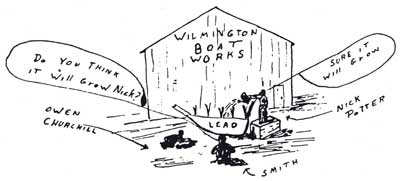 |
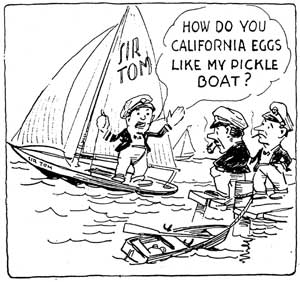
|
In the next two races, Geary showed the stuff of legends as SIR TOM won them both convincingly. Following this successful defense, SIR TOM was taken back to L. A., loaded onto the ALEXANDER and shipped home. (The regatta inspired another cartoon seen here. This one refers to the fact that SIR TOM was the oldest and smallest R-boat at the races. Just as sailors today refer to the fastest boat in a fleet as the "scratch" boat, early sailors called the smallest, slowest vessel the "pickle". Given Geary's gregarious nature, he may have actually said something like this.)

Also in 1927, PIRATE became the object of a truly unique program to get West Coast youngsters involved in R-boats on an unusual scale. At the urging of Fox Case, the Hearst newspapers commissioned Ted Geary to adapt PIRATE'S design to a 1/12 scale model of the boat for building and racing by schoolboys. In the first year. regattas were held at Westlake (now MacArthur Park) in Los Angeles and Seattle's Green Lake. The little yachts sailed in heats until the fleet was reduced to the fastest for the final.
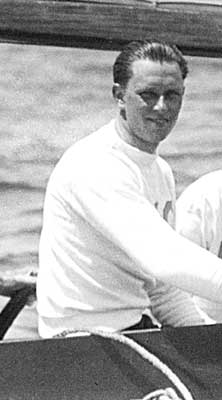 |
Fox Case, sportswriter for the L.A. Evening Herald. His "Starboard Watch" column
appeared regularly . He crewed on PIRATE in 1929 at Long Island Sound. |
At the first Los Angeles regatta the winner was young John K. Bussey. After winning a lovely silver cup, he was taken sailing aboard PIRATE as a guest of Tommy Lee. The Seattle regatta the same year was sponsored by the Seattle Post-Intelligencer and held on the waters of Green Lake. It was officiated by none other than Ted Geary and his sail trimmer from SIR TOM, the great Swift Baker. The winner was "J. Carlson" who received a fine cup donated by the Frederick & Nelson department store (see "Pond Boats" elsewhere in this web site.)

One of the best R-boat fleets ever assembled on the Pacific showed up at 1928 Mid-Winter Regatta to race for the Don Lee Cup. Among the eight boats entered were the great LIVE YANKEE (L. F. Herreshoff, Britt Bros., 1927) from Marblehead, Mass and Ron Maitland's LADY PAT (John Alden, Vancouver Drydock & Salvage Co., 1927) down from Vancouver, British Columbia. Tommy Lee steered PIRATE to fourth place for the series with finishes of 5-4-4-2-5. Undoubtedly disappointed at not winning a single race, Lee put PIRATE up for sale following the event.
This caght the eye of R-boat skipper Matt Walsh. In 1922, Walsh had sailed CALIFORNIA to victory in the San Francisco Perpetual in 1922 and was eager to get back into the R fleet. At Walsh's urging, Mr. Roger Marchetti of California Yacht Club bought the boat and Walsh became her skipper. In their very first race, on July 22, Walsh, Marchetti and two female crew decisively won the Los Angeles Times Perpetual Challenge Trophy beating the rest of the fleet by over two miles.
After a summer of racing in Los Angeles, PIRATE was shipped north in the fall aboard the freighter TEXAN. Walsh and PIRATE would again race "Uncle Arty" Rousseau and ACE for the San Francisco Perpetual. This time, the contest was to be a single match race between just these two boats. Although Walsh had been sailing her on San Francisco Bay for a week prior to the event, PIRATE suffered a breakdown in the race. Trailing by a minute and three-quarters early, her finish was made worse by the loss of a deck block for the main halyard that allowed the sail to drop several feet on the last leg. More at home in the bay chop, the robust ACE finished four minutes ahead of PIRATE to retain the trophy for another year.

PIRATE enjoyed her shining moment in yachting history in 1929. In the off season, Marchetti informed Walsh of his desire to sell the boat. Walsh had a pretty good idea that the boat had more speed than her 1928 season results might indicate. He approached another Cal Y. C. member, Commodore O. K. Hunsaker and suggested that he buy PIRATE. The deal was made. Walsh remained as skipper and immediately started planning for another campaign. Hunsaker was not the commodore of California Y.C. but of the Southern California Outboard Association. A keen competitor, and a boating booster, the new owner was enthusiastic when the skipper proposed a trip for PIRATE to the East Coast. After the visit of LIVE YANKEE the year before, a return gesture seemed in order.
PIRATE was once again loaded on to the deck of a freighter and, this time, shipped via Panama to Long Island Sound. Yachting magazine reported on the event: "The entry of Pirate in eastern races marks the first time that a Western-designed and built yacht, sailed by western yachtsmen, has raced on the Atlantic Coast" (May, 1929).
Walsh took L. A. Evening Herald sports writer Fox Case along with him as crew. Once at Larchmont, New York, they picked up local sailors Gordon Sykes and Manning Staires to crew. After two races, the scores for the top positions were very close. On July 23, Walsh, the old fox, made his move.
In the third race, the wind blew from the northeast. Walsh took the start at the committee boat and led the fleet to the weather mark off Scotch Caps. In clear air and riding up on a starboard tack lift, he tacked just three times. PIRATE held her lead on the reach across the sound to a jibing mark off Hempstead Harbor. The final leg went to the finish line off of the Larchmont breakwater. PIRATE finished well ahead of the R-boat fleet and a few of the larger, faster Q-boats as well.
Racing remained tight to the end of the regatta but PIRATE was clearly a contender. At the end of a week of very close racing, she finished on top by a single point (35 points) ahead of the famous YANKEE (L. F. Herreshoff, Britt Bros., 1925). DORESS (John Alden, Lawly, 1925) finished the week even with YANKEE but lost the tie-breaker. BOB-KAT (Henry Gielow, Lawley, 1926) was fourth with 33 points, PUFFIN (Nathaniel Herreshoff, Herreshoff Mfg. Co., 1927) placed fifth, two points behind. At the end, PIRATE, flying the burgee of the California Y. C., was named the R-Boat National Champion and was well on her way back to Los Angeles when the stock market crashed.

In 1930, PIRATE continued to race locally in Southern California. For this season, Hunsaker gave Walsh a free hand and the old veteran ordered a special suit of sails. A black mainsail and spinnaker were set off by a green jib. Not only were the colors unconventional but, in the middle of the mainsail was a cartoon pirate character complete with sword, hat and sash. Walsh liked to decorate sails this way. One of his own yachts, the great 45 footer THOROBRED, featured a horse head silhouette on her main.
The Don Lee Trophy races that year featured two entries from the East, Charles Deere Wiman's ALERT IV (Charles Mower, H. B. Nevins, 1928) from Indian Harbor and ROBIN (Starling Burgess, Abeking & Rasmussen, 1928) owned and sailed by Clare Farrand of Larchmont. PIRATE was sailed by Walton Hubbard in the first race and finished second. Matt Walsh skippered her for the rest of the series.
In a tight series, ROBIN won the cup despite missing the first race and an exciting final race where the lead changed hands several times. In that race, there was an awful collision between PIRATE and ALERT IV. In the incident PIRATE also struck a navigation buoy and her varnished hull was deeply gouged on the port side. This and other racing wounds led to her topsides being painted white a few years later.
In 1932, PIRATE was sold to Mr. Arthur Stewart son of William L. Stewart late president of Union Oil Co. of California. With R-boat racing waning during the depression, Mr. Stewart decided to convert PIRATE to a fast auxiliary. He had Garbutt & Walsh install a 44 hp. Gray Marine engine along with a marine head and some interior cabinetry. As a "cruiser", PIRATE was still raced successfully as a handicap sloop and won the Nordlinger Trophy under Stewart's command in 1932.
In 1930, Ted Geary finished his term as Commodore of Seattle Yacht club and moved his office from Seattle to Los Angeles. There were a number of large motor yacht projects underway in S. California and several yachts to his designs already there. The promise of more business in Southern California was a real one. The "movies" had became "talkies" and members of the seemingly depression-proof entertainment and petroleum industries had fallen in love with yachting.
While still in Seattle, Geary had designed a 100' fantail motor yacht for Mr. & Mrs. Merritt Adamson. Built at Blanchard's boat yard in Seattle, the yacht was christened MALIBU after the stretch of shoreline west of Los Angeles that the Adamsons called home.
When Geary moved to S. California, his friendship with the Adamsons deepened. Mrs. Rhoda May (Rindge) Adamson was a keen sailor and enthusiastic racer. When she bought PIRATE in early 1934, she named Geary as sailing master and co-helmsman. To prepare the boat for more serious racing, Geary had the engine and propeller shaft removed and redesigned the boat's sail and rigging plans. A more modern rig would allow the use of flatter Genoa jibs sheeted closer to the mainsail. This was popularly known as the "Diamond Rig" by sailors of the time. The spreaders were moved to a point half way between the forestay and the deck. The top attachment point of the upper shrouds was moved down to the forestay connection. A set of diamond struts, the same length as the spreaders were added at the same place. To control tip bend fore and aft, a jumper strut was fitted from forestay tang to the head stay and a smaller jumper was rigged on its own stay above the forestay.
The foretriangle height (P2) was increased from 31' to 35'-4" while the base (J) was kept at10'. This increased area forward in the plan was offset by a reduction in mainsail area; 14" were cut off the foot of the mainsail and the gooseneck was raised 18". At the same time, an 18" boomkin was added at the stern to attach a standing backstay. This brought the overall length of the vessel to 40'3". The last things added were jib sheet winches on the aft end of the house top, port & starboard, to trim the larger jibs.
In one of her first regattas in this configuration, PIRATE sailed to victory in the Nordlinger Trophy race of 1934, a two-day event off of Long Beach. Geary steered both days and, in the Sunday race, PIRATE caught and passed three Eight-Metres that had started ahead of her.
If the Larchmont win was PIRATE'S shining moment, then the season of 1935 was her swan song. Interest in R-boats was waning and those still racing did so in mixed fleets, sharing the starting line with the emerging Six-Metres. The Sixes had gained local popularity as one of the sailing classes in the 1932 Los Angeles Olympic Games.
PIRATE was markedly faster with the new rig. The first racing that year was for the San Diego Lipton Cup on January 2 off Los Angeles Harbor. The Lipton had not been back to San Diego since 1931 and the FRIENDSHIP skippered by Ashley Bown of San Diego Y. C. was the only challenger from the border town. In a twelve mile race, PIRATE beat FRIENDSHIP by 29 seconds. Seven Six-Metres followed.
In July PIRATE won the L. A. Times Trophy and repeated as Nordlinger Trophy winner. Geary and Mrs. Adamson shared the helm and completed a very successful season by going on to win all three races at the Pacific Coast Championship Regatta at San Diego. As a result of the season's results, the SCYA named Ted Geary "Southern California Skipper of the Year".
Through the depression and World War II, PIRATE remained in the Adamsons' ownership and was lovingly maintained by them. In 1952, young Merritt Adamson Jr. wed Miss Sharon Geary, daughter of PIRATE's designer. For a wedding present, the elder Adamasons gave the R-boat to the newlyweds. At the same time, the father of the bride drew up ink-on-linen renderings of Pirate's sail and construction plans, had them framed, and presented them to the young couple.
The younger Adamsons kept PIRATE for the next twelve years. While they rarely raced her, the boat was used regularly for day sailing and cruises to Catalina Island. Mrs. Adamson (now: Gee) remembers the boat as being strong, sound and a capable cruiser. True to the original design and purpose, they sailed her with no engine, pulpits or lifelines. The one concession to comfort was a marine toilet mounted in a cabinet just to starboard of the ladder. Mrs. Gee remembers this as not entirely satisfactory or especially private. During the period of Adamson family ownership, PIRATE was regularly and professionally maintained. This, more than any other single factor, is probably why PIRATE is alive and restorable today.

After over thirty years of Adamson family ownership, PIRATE was sold to Mr. Brooks Barnhill and Mr. Morton Caplan of Los Angeles. They cruised and raced the boat fairly actively. In PHRF handicap racing she continued her winning ways and picked up a few cups for both skippers. The new owners loved her immediately and, while they added lifelines and, occasionally, an outboard motor to comply with safety regulations, they resisted adding an inboard engine. Brooks Barnhill's letter relating to the purchase in 1964 and some of his experiences with the boat appears in the "Recollections" page of this site.
In the Seventies, PIRATE disappeared from yacht registers. She was owned for some time by Dennis Sullivan of Ventura, CA whe kept her more-or-less preserved. During that time, another auxiliary was installed and the wooden mast and boom were replaced with aluminum spars. At some time, the deck began to leak and was sheathed with plywood in an effort to make her tight. Much of the repair work was performed using epoxy resins which interacted badly with the original materials.
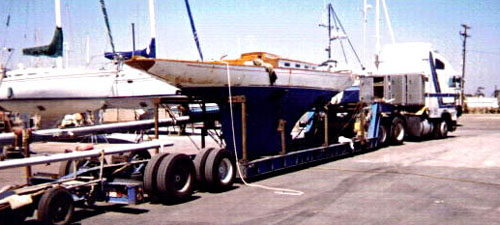
PIRATE loaded on the Dudley Yacht Transport
trailer at
Channel Islands Boatyard for her trip north to Seattle, June 1999.
Scott Rohrer
In the late nineties, PIRATE'S owner, Ms. Adele Jacobson of Oxnard, CA., donated PIRATE to the Blue Whale Sailing School of Santa Barbara. Founded by Mr. John Ascuncion, Blue Whale developed sailing programs for children of South Seas Islander families to give them opportunities to develop boating interests. In 1999, Blue Whale moved their operations to Lake Tahoe but chose not to take PIRATE along. Mr. Ascuncion contacted the Center for Wooden Boats in Seattle hoping that the boat could return to the place of her origins and find a happy home there. The vagaries of the tax laws prevented them from donating her directly to CWB. This created an obstacle as the Center didn't have the funds to purchase PIRATE.
Ultimately, an alternative plan was developed whereby a group of Puget Sound yachtsmen and women formed the "Pirate Syndicate" to purchase the boat and bring her North. Mr. Ascuncion and his wife contributed to and structured the sale to make it affordable for the buyers and palatable to the revenuers.
In late July, Scott Rohrer went to Ventura to pack the boat up and make her ready for the trip North. A truck from Dudley Boat Transport showed up, the crew at Channel Islands Boatyard loaded PIRATE and she started the trip back to the city of her origin.

Through the summer and fall of 1999, PIRATE was kept at the Center for Wooden Boats' site at South Lake Union, just a half mile from Lake Union Drydock where she was built and launched almost seventy-five years earlier. In October, the Pirate Syndicate officially donated this graceful racer to the CWB in a ceremony at the Center. Following that, her house & deck were removed at the Cadranell Yacht Landing before she was moved to the boatwright Brad Rice's shop in Ballard where she was re-framed and refastened before relaunch in Ballard in 2003. She was towed to the Center for Wooden Boats where her house, teak decks, and deck hardware (mast & boom) were finished.
Since 2005, the boat has become the center of a new focus at CWB on northwest yachting and boat building. In all, nearly $130,000 was raised to fund a museum-quality restoration using techniques and materials as close to original as is possible in this age. PIRATE has been sailing since 2005 and is available to the public for sailing and interpretation of early boat building in Seattle. As she sits, she is the most accurate example of a R Class sloop on the Pacific Coast.
Her nominations to the U.S. National Register of Historic Properties, Washington State Historical Record and the Historic American Engineering Record (HAER) are unique to historic racing yachts (ie.: she is the only one so honored) and raises the bar for similar projects in the U.S.
We thank King County 4Culture for the grant that funded Pirate's nomination to HAER, including LIDAR scans of her hull. These scans affirmed that, although PIRATE's hull had been 85% re-framed and re-fastened, she is symmetrical. An accurate lines plan also came of this.
Done to the U.S. Secretary of the Interior's Standards for Historic Vessel Preservation Projects and Guidelines for Applying the Standards. (available on-line at; http//hnsa.org/standa.htm), the required preservation of "original fabric", and faithful use of materials & equipment as close to original as possible, assure her place on the federal records for the longer term. Also administered by the U.S. Dept. of the Interior (via the U.S. Parks Svc.), HAER preserves PIRATE's engineering, construction details and restoration path at the Library of Congress in perpetuity. Both federal honors are based on a strict fidelity to original materials and methods and produce vessels that perform as close to the original designs when "interpreted by use." As such, there can be no doubt about the "traditional" (an overworked term) nature of the work. Epoxy and fiberglass jobs rarely comply with these standards — and, in our case, the Secretary"s guidelines simplified decision-making for the team.
PIRATE is "in-class" as an R-class sloop, rating just under the class limit of 20', with valid rating certificate. Beautifully conserved by a long string of knowledgeable owners (all amateur yachtsmen) and their mostly professional hands, in the best boatyards of 1930s Los Angeles. Today, she sits in the water exactly on her original freeboard at the aft end of her waterline. At the forward end, she is high by one-eighth of an inch. Even in 1926, a builder would not be troubled by this.
J. Scott Rohrer.
Engineering drawings of PIRATE are available from the Library of Congress' Historic American Engineering Record (HAER) as R-Boat Pirate, The Center for Wooden Boats, Seattle, King County, WA. Her lines drawing is available as a PDF file here: Pirate (R11) Lines Drawing. Drawings available from HAER are:
This drawing was developed from these (and other) 3D scans made of PIRATE.
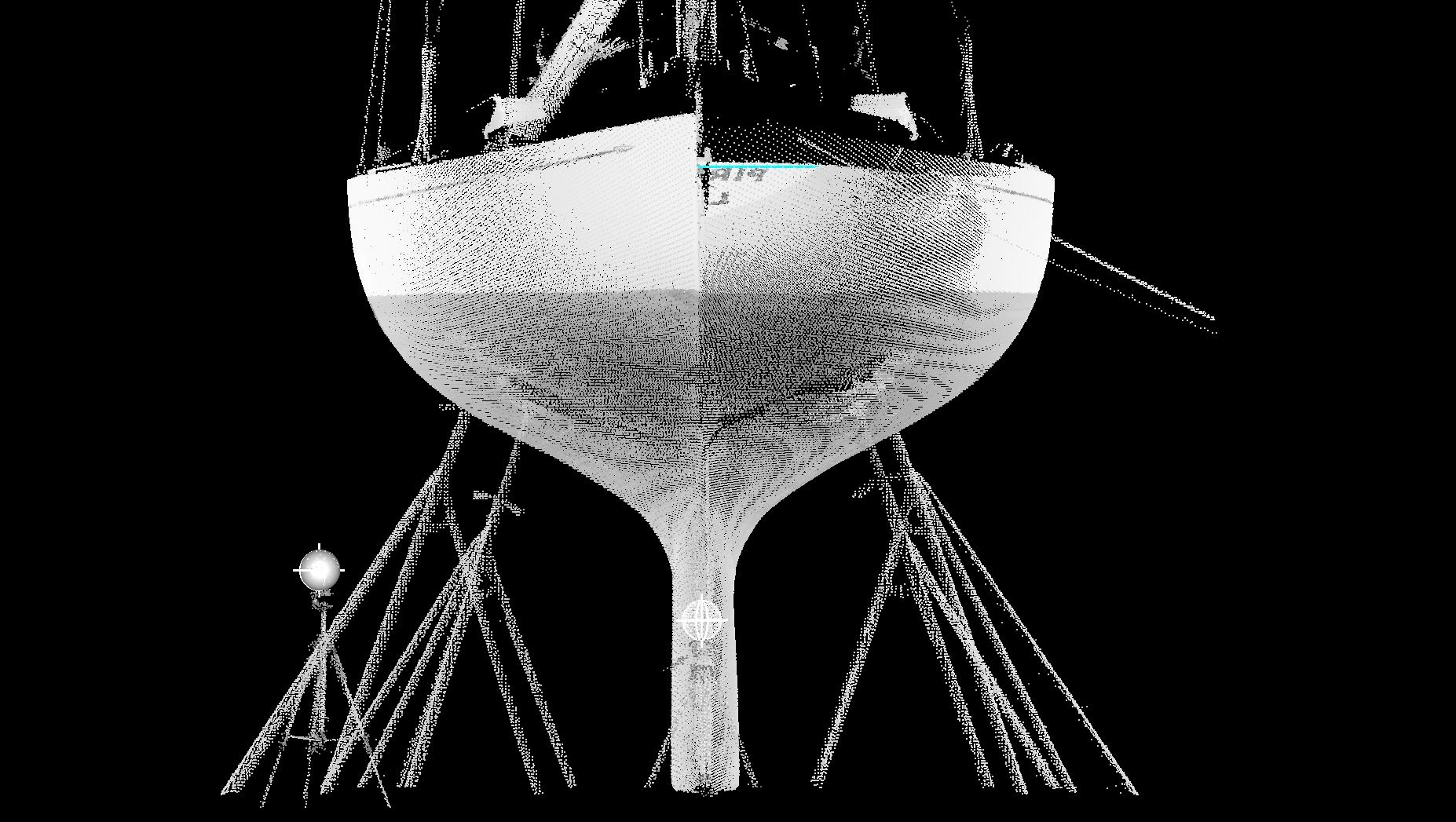
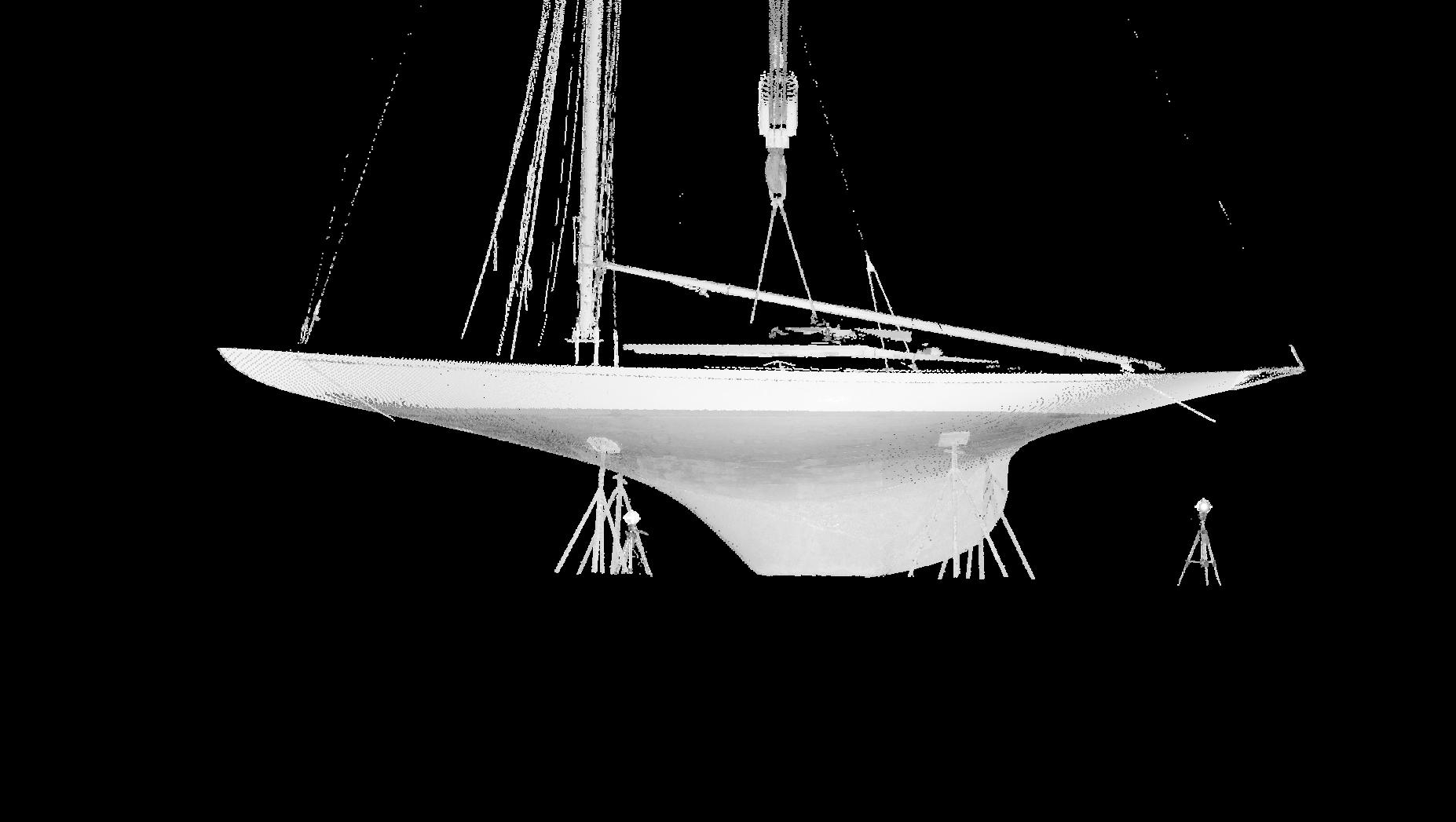
A fan of PIRATE in Turkey built this 3D model from the information in these drawings.
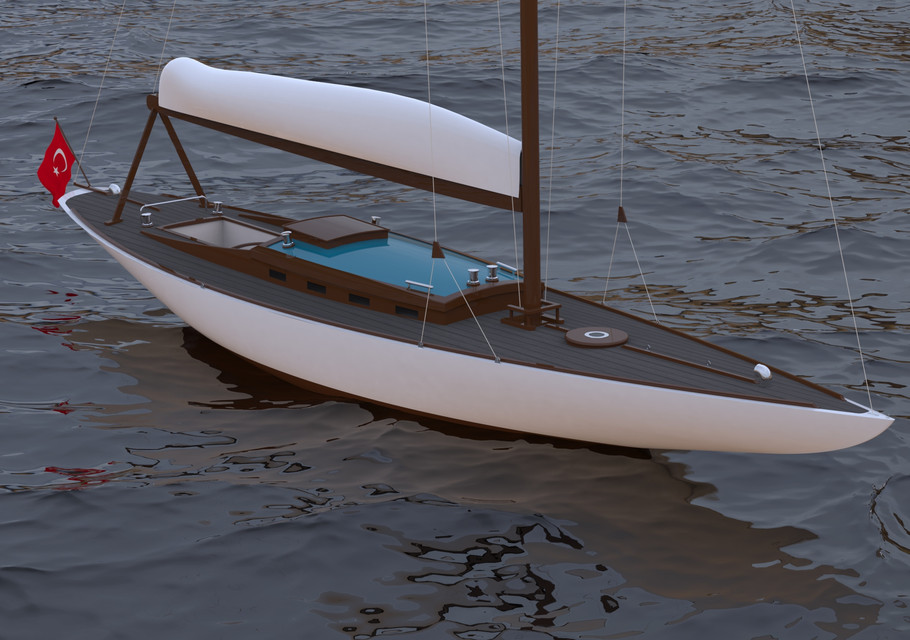
For their vital assistance on the research and production of the above, special thanks go to Paul Marlow, Tom Skahill and Pirate web designer David Kennedy.
The Geary Family Archives
Mrs. Sharon Adamson Gee is Ted Geary's daughter. She and husband Geoff Gee have generously supported the PIRATE project in a number of ways. On two separate occasions they have invited this author to their Malibu home, made their family scrapbooks and files fully available and eagerly assisted in the research. The wonderful photos of PIRATE sitting aboard the H. F. ALEXANDER are from these files as are the photographs of the 1934 mast. Geoff's diligent scanning of these and other images has made reproduction of them particularly easy.
It was from this collection that we were able to piece together the details of the 1927 PIRATE pond boat program. The fragile full-page reprints from the L. A. Evening Herald were found there and lent to us for "flat bed" scanning. Special thanks to Geoff & Sharon.
Newport Harbor Nautical Museum
The wonderful W. C. Sawyer photos were found and provided to us by Curator Marcus De Chevrieux at the Newport Harbor Nautical Museum. Most of them were discovered in the last year and have not been published before. This museum devotes a great part of their display space to yachting and pleasure boating.
Newport Harbor Nautical Museum
151 East Coast Highway
Newport Beach, CA 92660
tel. (949) 675-8915
fax. (949) 675-8864
website http://www.newportnautical.org
Puget Sound Maritime Historical Society
The Puget Sound Maritime Historical Society photo collection includes thousands of marine images from the likes of Webster & Stevens and the Joe Williamson Collection among others. Housed at Seattle's Museum of History & Industry. The collection is managed by Mrs. Phyllis Kelly. The Society's library also provided valuable research materials for this piece. Many thanks to librarian Jack Carver and the crew at PSMHF for their help.
Puget Sound Maritime Historical Society
2700 24th Ave. E.
Seattle, WA 98112
website: http://www.pugetmaritime.org
Museum of History & Industry
The photo archives at the Museum of History & Industry include the Seattle Post-Intelligencer collection from which the Webster & Stevens photos of the PIRATE launch and m/y MALIBU came. We are grateful to volunteer Steve Wilen and curator Howard Giske for their effort on our behalf. The panoramic photo of PIRATE hanging just before launch has never been published before.
Museum of History & Industry
860 Terry Ave.
Seattle, WA 98109
Sophie Fry Bass Library
2700 24th Avenue E.
Seattle, WA 98112
tel: (206) 324-1126
website: https://mohai.org
California Yacht Club
Frank Gleberman, historian at the California Yacht Club, and club manager Ted Olsen, were extremely helpful to our research on this piece. The access given to us added considerably to PIRATE'S story as well as those of the Cal Y.C. members in her past. This great club is especially aware of its rich heritage as a complete club history is presently in the works. Many thanks to the club and the Hathaway family for their interest in the PIRATE project.
California Yacht Club
4469 Admiralty Way
Marina del Rey, CA 90292
tel: (310) 823-4567
website: http://www.calyachtclub.com
Los Angeles Maritime Museum
Los Angeles Maritime Museum has in their collection, Mr. John K. Bussey's PIRATE pond boat that won the first regatta for such craft in Los Angeles in 1927. Curator Marifrances Trivelli gave us unfettered access to this boat and put us in touch with Mr. Bussey. All of this has added tremendously to the development and historical accuracy of the modern program. Thank you.
Los Angeles Maritime Museum
Berth 84
Foot of 6th Street
San Pedro, CA 90731
tel: (310) 548-7618
fax: (310) 832-6537
website: http://www.lamaritimemuseum.org
The Rosenfeld Collection
The Rosenfeld Collection, purchased in 1984 by Mystic Seaport, Inc. is one of the largest archives of maritime photography in the United States. This Collection of nearly one million pieces, documents the period from 1881 to the present representing the evolution of photographic technology and development in the maritime industry, over the last one hundred years. The Collection is built on the inventory of the Morris Rosenfeld & Sons photographic business, located in New York City from 1910 to the late 1970s.
Due to the chronological arrangement of the negatives in the Collection, the evolution of sail, hull, and engine design spanning more than a century, can be observed by the researcher. The America's Cup Races are fully represented from 1885 to 1992.
For further information, please contact:
The Rosenfeld Collection
Mystic Seaport Museum, Inc.
75 Greenmanville Avenue
P.O. Box 6000
Mystic, CT 06355-0990
tel: (860) 572-5383
fax: (860) 572-5320
email: collections@mysticseaport.org
website: http://www.mysticseaport.org/public/collections/rosenfeld
Los Angeles Yacht Club
Historian Frank Person at Los Angeles Yacht Club provided us with fairly complete histories of the R-boat trophies of the 20s and 30s as well as furnishing detailed race results where we had nothing before. We are grateful to Frank and LAYC for filling in these gaps for us.
Los Angeles Yacht Club
285 Whalers Walk
San Pedro, CA 90731
tel: (310) 831-1203
fax: (310) 833-0922
website: http://www.layc.org